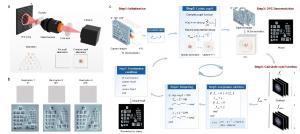
Aberration-Free Quantitative Phase Imaging

Figure 1: The flowchart of ACDPC iterative reconstruction joint optimization algorithm. (a) ACDPC imaging system based on half-annular illumination. (b) Three annular illumination patterns and their intensity images. (c) The flowchart of ACDPC method.
Joint Phase-Aberration Reconstruction via Annular Differential Phase Contrast Illumination
CHENGDU, SICHUAN, CHINA, June 23, 2025 /EINPresswire.com/ -- Check the full article here: https://www.oejournal.org/article/doi/10.29026/oes.2025.240037Biological cells exhibit nearly transparent characteristics with weak absorption properties in the visible light spectrum, resulting in extremely low optical contrast between cells and the surrounding medium under traditional bright-field microscopy. To enhance imaging contrast, conventional methods rely on chemical staining or fluorescent labeling, introducing exogenous absorption/fluorescence probes to visualize cellular structures. However, these approaches suffer from drawbacks such as phototoxicity, photobleaching, and poor biocompatibility, severely limiting long-term dynamic observation of living cells. Quantitative phase imaging (QPI) utilizes the inherent physical property of cellular phase (thickness) as an endogenous “probe”, resolving cellular thickness, refractive index, and 3D topography with nanoscale accuracy. It provides a new avenue for dynamic observation of living cells and nanoscale biological studies.
As a significant branch of QPI technology, differential phase contrast (DPC) has attracted considerable attention due to its advantages of being non-interferometric and low-cost. However, its theoretical framework relies on the “weak object approximation”, linking intensity images to sample phase through a linear model. This simplified model introduces two fundamental limitations. First, the phase reconstruction result is highly dependent on the precise modeling of the phase transfer function (PTF) under an ideal pupil. In practical optical systems, however, wavefront aberrations couple with the sample phase, leading to significant reconstruction errors. Second, the conventional half-circle illumination suffers from the problem of PTF response cancellation, resulting in the loss of low-frequency phase information and making it difficult to accurately reconstruct the fine structure of weak phase objects. These limitations significantly compromise the robustness of DPC in non-ideal optical environments and restrict its practical applicability in frontier biological research, such as cellular morphology characterization and tracking of subcellular dynamic processes.
In this work, the research team led by Professors Qian Chen and Chao Zuo at Nanjing University of Science and Technology proposed an Aberration-corrected Differential Phase Contrast (ACDPC) QPI method based on annular illumination. This method employs an iterative phase retrieval algorithm to jointly reconstruct both the sample phase and system aberrations from the raw intensity images, enabling high-quality QPI with automatic aberration detection and correction. Thereby, it provides a novel solution for high-precision quantitative phase analysis of biological specimens in complex optical systems.
ACDPC implements a joint phase-aberration reconstruction framework using annular illumination. By employing an optimized annular illumination matching the objective's numerical aperture (NA) (NAill=NAobj) [7], it optimizes the PTF response across the entire frequency band under an aberrated pupil. This effectively alleviates the low-frequency loss problem in conventional half-circle illumination. Furthermore, the team developed a joint inversion algorithm that integrates simulated annealing tempering and regularization constraints, which incorporates an adaptive natural exponential decay strategy, simultaneously retrieving system aberrations and object phase by minimizing intensity residuals. Thus, it overcomes DPC's inherent sensitivity to system aberrations without prior knowledge requirements. The researchers demonstrated that a three annular illumination satisfies the rank condition constraint for joint phase-aberration reconstruction. Compared to the four images required in traditional DPC, ACDPC reduces image acquisition time while delivering aberration-free QPI with high phase sensitivity.
Simulations and experimental results validated the robustness of ACDPC against fifth-order aberrations, achieving high-fidelity quantitative phase reconstruction under complex aberrations. Even under large defocus conditions (+20 μm), the reconstruction results of ACDPC remain superior to those obtained by conventional DPC, confirming its strong robustness for phase retrieval in the presence of complex wavefront distortions.
The ACDPC method, leveraging optimized annular illumination and a joint phase-aberration reconstruction algorithm, achieves effective decoupling of system aberrations from object phase using only three intensity images. This approach effectively overcomes the inherent sensitivity of traditional DPC to system aberrations, significantly enhancing both the resolution and robustness of QPI under complex optical systems. It offers a highly robust technical solution for high-precision quantitative phase analysis of dynamic processes in living cells.
The Smart Computational Imaging Laboratory (SCILab: www.scilaboratory.com) is affiliated to the “Spectral Imaging and Information Processing” Innovation Team of the Ministry of Education's Changjiang Scholar and the first batch of “National Huang Danian-style Teacher Team”, led by Professor Qian Chen, the leader of the national first-level key discipline of optical engineering at Nanjing University of Science and Technology. Professor Chao Zuo, the academic leader of the laboratory, is a distinguished professor of the Ministry of Education’s Changjiang Scholars Program, a Fellow of SPIE | Optica | IOP, and is selected as a Clarivate Analytics Highly Cited Scientist in the World. The laboratory is committed to developing a new generation of computational imaging and sensing technologies. The research results have been published in more than 270 SCI journals, of which 46 papers were selected as cover papers of journals such as Light, Optica, AP, PhotoniX, etc., 25 papers were selected as ESI highly cited/hot papers, and the papers have been cited nearly 20,000 times. Professor Zuo has won the Fresnel Prize of the European Physical Society, the first prize of the Technological Invention Award of the Chinese Society of Optical Engineering, the first prize of the Basic Category of the Jiangsu Science and Technology Award, and the “Special Commendation Gold Award” of the Geneva International Invention Exhibition.
Andrew Smith
Charlesworth
+44 7753 374162
marketing@charlesworth-group.com
Visit us on social media:
LinkedIn
YouTube
Other
Distribution channels: Book Publishing Industry, Electronics Industry, Science, Technology, Telecommunications
Legal Disclaimer:
EIN Presswire provides this news content "as is" without warranty of any kind. We do not accept any responsibility or liability for the accuracy, content, images, videos, licenses, completeness, legality, or reliability of the information contained in this article. If you have any complaints or copyright issues related to this article, kindly contact the author above.
Submit your press release

